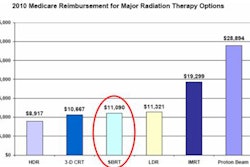A naturally occurring, harmless human virus given in combination with radiation therapy (RT) has shown significant benefit in patients with advanced cancers, according to results of a study conducted by the Institute of Cancer Research in London.
Solid tumors shrank or stabilized in more than half of the patients who participated in the clinical trial. None of the patients experienced significant side effects, an article published online May 18 in Clinical Cancer Research reported.
The objective of the trial was to determine the safety and feasibility of combining intratumoral reovirus (Reolysin, Oncolytics Biotech, Calgary, Alberta) and radiation therapy in patients with advanced cancer, and to assess viral biodistribution, reoviral replication in tumors, and antiviral immune responses.
Laboratory tests on tumor cells showed that Reolysin appeared to magnify the effects of radiotherapy, so researchers enrolled 23 patients with a range of advanced solid tumors, including colorectal, lung, ovarian, and skin cancer in the phase I study. All enrolled patients had advanced disease that had stopped responding to radiation therapy and/or traditional drugs used for treatment.
In the first stage of the study, seven patients received 20 Gy of radiotherapy in five fractions, plus two intratumoral injections of Reolysin. In the second stage, 16 patients received a radiotherapy dose of 36 Gy delivered in 12 fractions, and these patients received two, four, or six doses of Reolysin. The patients received their radiotherapy treatment at either the Royal Marsden Hospital in London or St. James University Hospital in Leeds, according to principal investigator Dr. Kevin Harrington, senior lecturer at the Institute of Cancer Research.
Tumor response could be measured in 14, or 60%, of the patients. The researchers reported that in the low-dose radiation group, two of seven patients had a partial response, and five had stable disease. In the high-dose group, five of seven patients had a partial response and two had stable disease. One patient had a large tumor mass of his parotid gland, which shrank enough to be surgically removed. Another patient with metastatic melanoma was still alive 17 months after the treatment commenced.
There was no dose-limiting toxicity, according to the researchers, and the most common toxicities were grade 2 or lower pyrexia, influenzalike symptoms, neutropenia, vomiting, and asymptomatic lymphopenia.
The researchers plan to initiate a clinical trial to investigate the treatment combination in patients with newly diagnosed cancers that would normally be treated with radiotherapy alone to see if it could improve cure rates.
Copyright © 2010 AuntMinnie.com



















